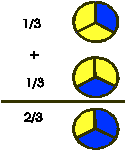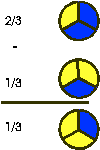Addition
| In this example fractions 1/3 + 1/3 may be combined to give (1 + 1) / 3 since they have the same denominator, the new numerator is the sum of the old numerators, the new denominator is the common denominator 3. | |
 |
|
|
In this example fractions 1/2 + 1/3 can not be combined as in example 1 because they do not have the same denominator. Fractions 1/2 and 1/3 have the least common denominator (LCD) of 6. Therefore, fraction 1/2 has to be multiplied by 3/3 to make 3/6 and fraction 1/3 has to be multiplied by 2/2 to make 2/6. |
Subtraction
|
Example 1  |
In this example fractions 2/3 - 1/3 may be subtracted to give (2 - 1) / 3 since they have the same denominator, the new numerator is the difference of the old numerators, the new denominator is the common denominator 3.
|
|
Example 2: |
In this example fractions 1/2 - 1/3 can not be subtracted as in example 1 because they do not have the same common denominator. Fractions 1/2 and 1/3 have the least common denominator (LCD) of 6. Therefore, fraction 1/2 has to be multiplied
by 3/3 to make 3/6 and fraction 1/3 has to be multiplied by 2/2 to make 2/6.
|
| Example 3:
|
In this example fractions 1/2 - 1/9 - 1/6 have the least common denominator (LCD) of 2 x 3 x 3 = 18. Therefore, fraction 1/2 has to be multiplied by 9/9 to make 9/18. Fraction 1/9 has to be multiplied by 2/2 to make 2/18 and fraction 1/6
has to be multiplied by 3/3 to make 3/18.
|